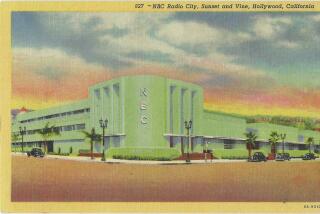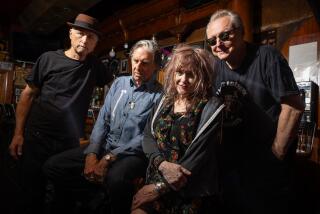XM radio: It’s out of this world
I never really worried about becoming a couch potato, but because of XM radio, I’m a car potato.
I was late for lunch with a studio executive the other day because I couldn’t leave the car until hearing the end of Butch Hancock’s “Red Blood (Dripping From the Moon).” And that was me in the parking lot at Whole Foods, entranced by Senegal’s incomparable Baaba Maal, crooning “Salimoun.” L.A. traffic no longer drives me insane. Not when I can hear X’s “The New World,” Eric B & Rakim’s “Follow the Leader” or the Hangdogs’ “(If You’re So Country Then) Drink Yourself to Death” all at the flick of a dial while I’m poking along on the 405. And I confess: I drove around and around my own block recently, transported back to my childhood as XM’s ‘60s channel played old tapes from Miami’s Top 40 station, WQAM, complete with high school basketball scores and ads from local car dealers.
Think about it. When was the last time you didn’t want to leave your car because there was too much good music on the radio? For years now, radio in Los Angeles, not to mention the rest of the country, has been a vast wasteland, hijacked by robotic DJs, research-driven music playlists and even more ads than they play in movie theaters these days. Outside of mornings spent with KCRW’s Nic Harcourt, if I wanted to hear music without being subjected to an annoying parade of ads, I had to rely on CDs or an iPod. That is, until I got XM radio.
I’m not a neutral observer here, I’m a fan, and with good reason: XM has rescued great music from exile. With 4.4 million subscribers, the satellite network is booming, having more than doubled its subscriber base in less than a year. With more than 110 million Americans paying for cable or satellite TV, it’s hardly a reach to imagine that someday soon XM and its satellite radio rival, Sirius, will have 50 million or more subscribers. In addition to 67 commercial-free music channels offering everything from jam bands and jazz to bluegrass and classic soul, XM has news, comedy and weather, plus live broadcasts of every major league baseball game, so you can hear the peerless Vin Scully even in the farthest corners of the country. In tandem with AOL, XM provided blanket coverage of Live 8, offering live broadcasts on seven different channels.
What makes XM such a brilliant concept is that in a musical era when, through downloading, we can get pretty much any kind of music anytime we want, listeners are desperate for a mediator -- a savvy tastemaker -- who can help us separate the wheat from the chaff. Having XM in your car (or at home and on your computer) is the equivalent of having dozens of Harcourts, each with unique programming expertise. Dermot Hussey, who programs XM’s reggae channel, the Joint, has an encyclopedic knowledge of the genre, having been a DJ for years in Jamaica. Eddie Kilroy, who programs the hard-core country channel, Hank’s Place, was a professional rodeo rider as well as a country music producer.
But for me, the biggest shock is that XM’s programming chief isn’t a baby-faced computer wizard. He’s Lee Abrams, a stocky, gray-haired guy whom you’d expect to bump into backstage at a Tom Petty concert. Abrams is an unlikely savior. Back in the 1970s, Abrams was the radio guru who dreamed up album-rock radio, the format that helped kill off free-form radio and usher in a generation of research-driven pop pap.
Abrams admits that his fascination with research helped speed radio’s downfall. “I got too caught up in it back then,” he explained on a recent visit here. “At the time, free-form radio
was too elitist and self-indulgent. So I was a hero to the radio station owners, but to critics, I was the evil guy. But I thought radio needed some discipline.
Of course, now radio is way
over-disciplined. It doesn’t
need a Manhattan-sized phone book full of research numbers
-- it desperately needs some
art.”
Eventually Abrams grew tired of the restraints of corporate radio. When a headhunter asked whom he’d recommend to program a new satellite radio company, he said, “You’re talking to him.” He signed on with XM in 1998, overseeing the network’s launch in 2001. Equipped with a booming voice that echoes across a noisy restaurant, he has the born-again fervor of a man given a rare second chance in life.
“Our mandate at XM is -- do it differently,” he said. “Most of our programmers come from terrestrial radio, but they hated it. They were like an amazing musician who was stuck playing ‘Feelings’ in a Holiday Inn three times a night -- and now they get to be in Pink Floyd. Every one of our stations has a real point of view. You might be appalled by it -- on Hank’s Place, we’ve got people calling in terrorist alerts from their pickup trucks -- but you can’t say that it’s boring vanilla radio. And if you don’t like the point of view, you’ve got 150 other stations to choose from.”
As a young radio junkie in the Midwest, Abrams would hitchhike so he could observe people’s car-radio listening habits. He’s famous for bombarding his staff with manifestoes that exude his evangelical zeal. As he put it in a recent memo: “Radio has de-evolved to being Dumbed Down, Cliche, Infected by cheesy Production ‘libraries.’ It is our responsibility to Bring Sonic Brilliance Back To Radio. The XM way! It starts with thinking Beyond Radio. The goal is to Completely Change the Sound. Not evolve or update. Forget radio exists. Pretend it’s 1921 and radio production has never been done before. Ambient. Big. Quirky. Campy. Dreamy. Anything but ‘radio.’ You are a media artist, not a radio producer!”
Abrams’ vision of XM as something more than radio -- as a wild-eyed leap forward -- couldn’t be more timely. Along with Apple, Grokster, Yahoo, AOL and even Starbucks, XM is an integral part of a revolutionary reshaping of the music business.
As recently as five years ago, the industry’s power players were a small cadre of giant record companies, MTV and a handful of radio conglomerates. Now everything has changed. MTV no longer promotes music -- or even treats it with respect. Its recent Live 8 broadcast was a debacle, revealing it as a network in the thrall of personality, not artistry. Ditto for terrestrial radio, which as XM president Hugh Panero noted, has “shifted their allegiance from music fans to advertisers while completely ignoring new technology -- terrestrial radio is probably the last analog format in America.”
The record companies have made an art form out of their reluctance to embrace the new digital world, alienating their fan base with clumsy legal threats and onerous copyright protections. When I was a kid, I bought records because they came from a cool label like Asylum or Island Records. Today the only brand that has any goodwill with music fans is Apple, via iPod and iTunes. Stepping into the breach is Starbucks, which is using its own brand loyalty to become a music retailer, selling new CDs, sometimes on an exclusive basis, in its 6,900 outlets in the U.S. Starbucks sold an amazing 775,000 copies of Ray Charles’ Grammy-winning “Genius Loves Company,” and has been the prime mover behind Alanis Morissette’s new acoustic reworking of “Jagged Little Pill.”
The possibilities are obvious. Record companies have long assumed no one could replicate their marketing and distributing clout, but if I were a manager with the right artist, staring at Starbucks’ demographics and its 6,900-store reach, why wouldn’t I cut out the middleman and simply sell my music via a Starbucks label? XM already has a channel programmed by Hear Music, a Starbucks-owned music unit. Today XM will announce the launch of a series of music-compilation CDs, the first one with newly recorded music from the likes of Tracy Chapman, Jason Mraz and the John Butler Trio available exclusively at Starbucks outlets. It also recently formed an alliance with AOL and AEG, which has a big concert promotion wing. The deal means that fans can hear live concert shows of their favorite artists from dozens of tour stops across the country.
XM still faces the challenge of how to compete in a world increasingly dominated by digital downloading devices. It has a portable XM2go receiver with enough memory to allow subscribers to record five hours of XM programming. The key will be whether XM can someday strike a deal to create a TiVo-style device that could record an even heftier chunk of programming.
“That’s where it’s going,” said Panero. “There’s clearly going to be a convergence of devices that will allow people to toggle between XM broadcasts and something with their own personal music files.”
Years ago, Bruce Springsteen wrote the mournful “57 Channels (And Nothing On),” lamenting how, despite all of our technological advances, mass media was more one-dimensional than ever. It’s time Bruce did a rewrite. XM has recaptured the pioneering spirit of great radio, where you spin the dial and never know what wonderful music you might hear next.
More to Read
The biggest entertainment stories
Get our big stories about Hollywood, film, television, music, arts, culture and more right in your inbox as soon as they publish.
You may occasionally receive promotional content from the Los Angeles Times.








